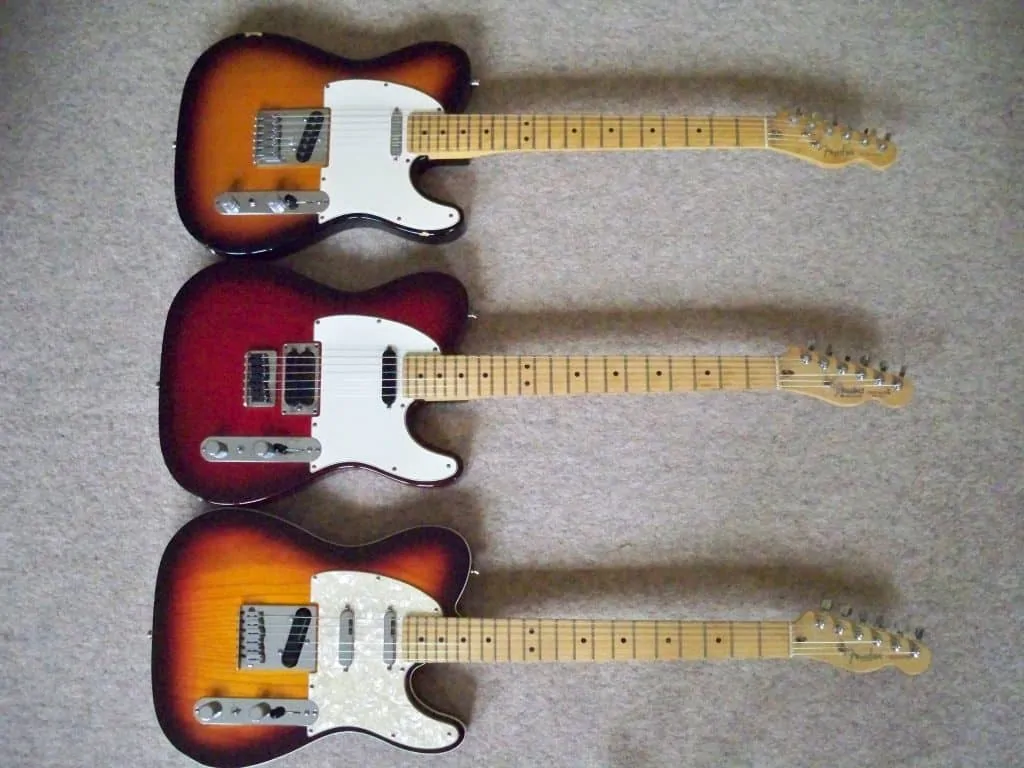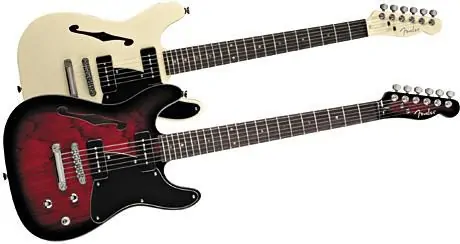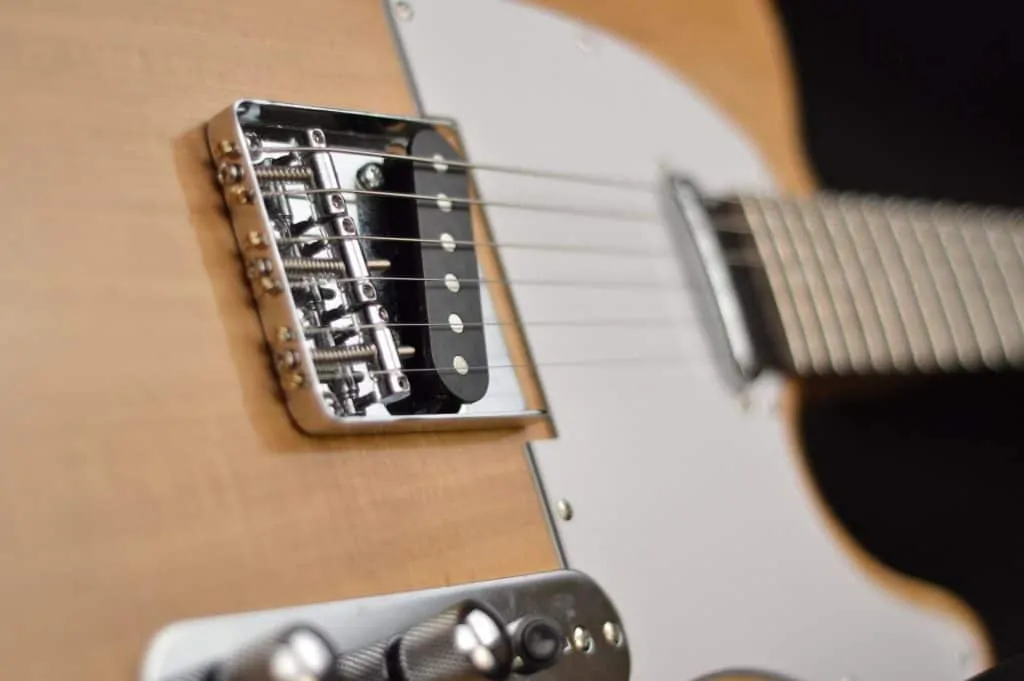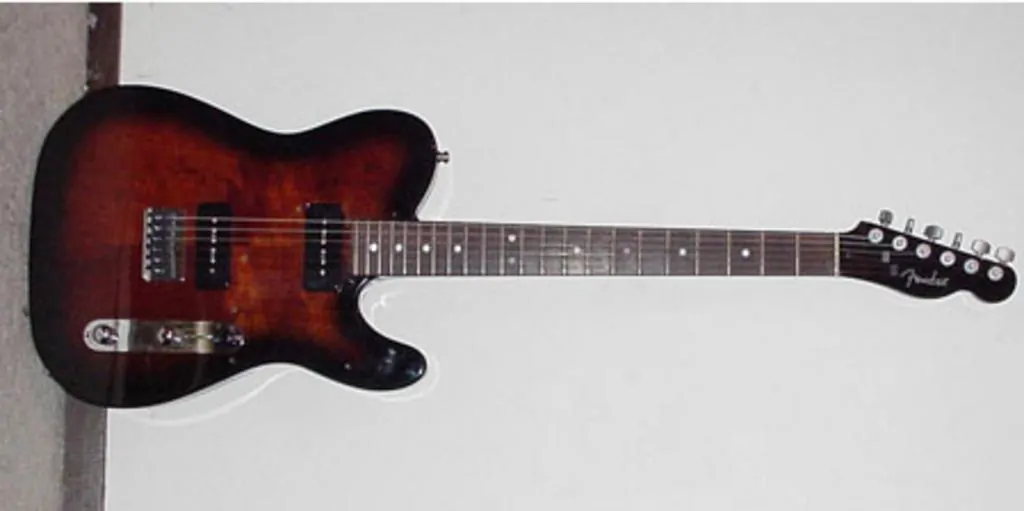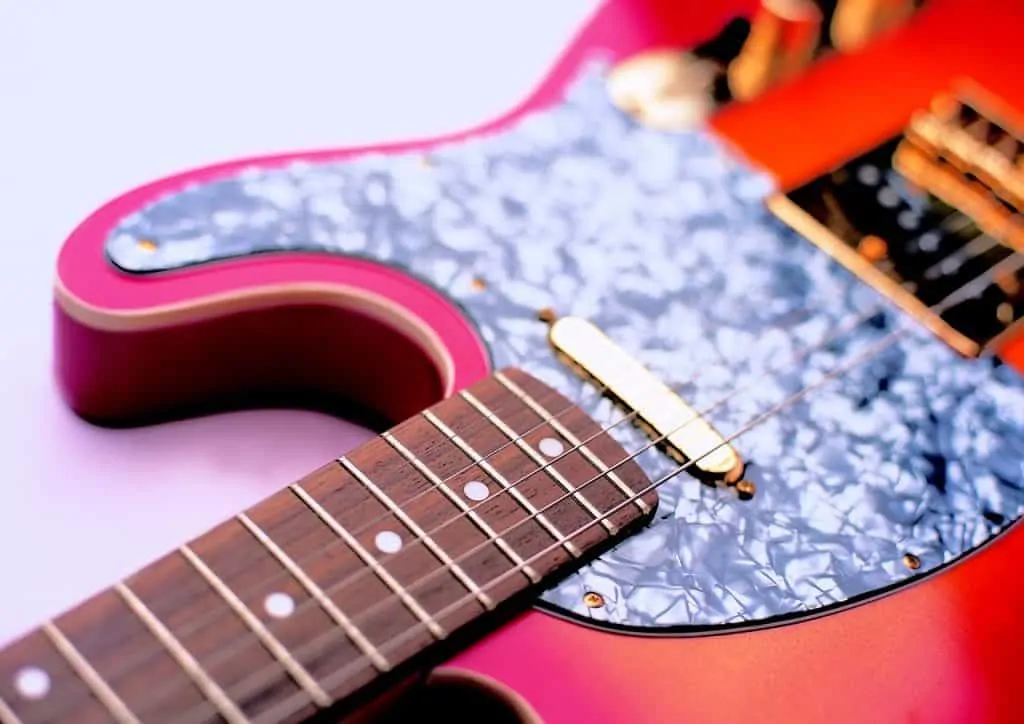Both Squier and Fender produce the Classic Vibe series, a very popular lineup of bass and electric guitars conserving the vintage feel, look and sounds of the original Fender instruments.
There’s a twist, though. Fender and Squier add some modern retouches to these instruments, distinctive features that turn the Classic Vibe into such an attractive lineup the price becomes almost unbeatable…if you’re into vintage instruments.
Squier’s own line of Classic Vibe instruments is just the cheaper version of Fender’s own workshop. To achieve lower prices, they trade some quality tonewoods (like ash or mahogany) for the cheaper basswood; and lower the quality of the pickups.
Stil, Squier Classic Vibe represents some of the best cheap guitars that play, feel, and look like pro-grade instruments. You see, degraded, vintage and “old-school” instruments always look professional, and the Classic Vibe Telecaster does a great job retaining all of these values.
Personally, I commend the Squier Classic Vibe Telecaster as one of the best budget guitars for pro players.
Telecasters are famous for their simple layout and mellow tones. And a degraded Telecaster always looks better than a new one.
Let’s take a look at the qualities of the Squier by Fender Classic Vibe Telecaster and see how this can be a good guitar for experienced and advanced guitarists.
Remember Squier by Fender has the other 7 lineups. I already covered the Vintage Modified series and the Squier Bullet series.
Lastly, you can browse on Squier’s page to check the available models of the Classic vibe series in your country. The ones I find truly amazing are, which are also the ones more available internationally (outside of the USA):
- Squier Classic Vibe Telecaster ‘50s
- Squier Classic Vibe Telecaster ‘60s Thinline (a semi-hollow guitar).
There are also Stratocaster guitars, Jaguar guitars, Mustang guitars, and various basses (Mustang, Precision, Jaguar, Jazz, Jaguar, Bass V, and Bass VI).
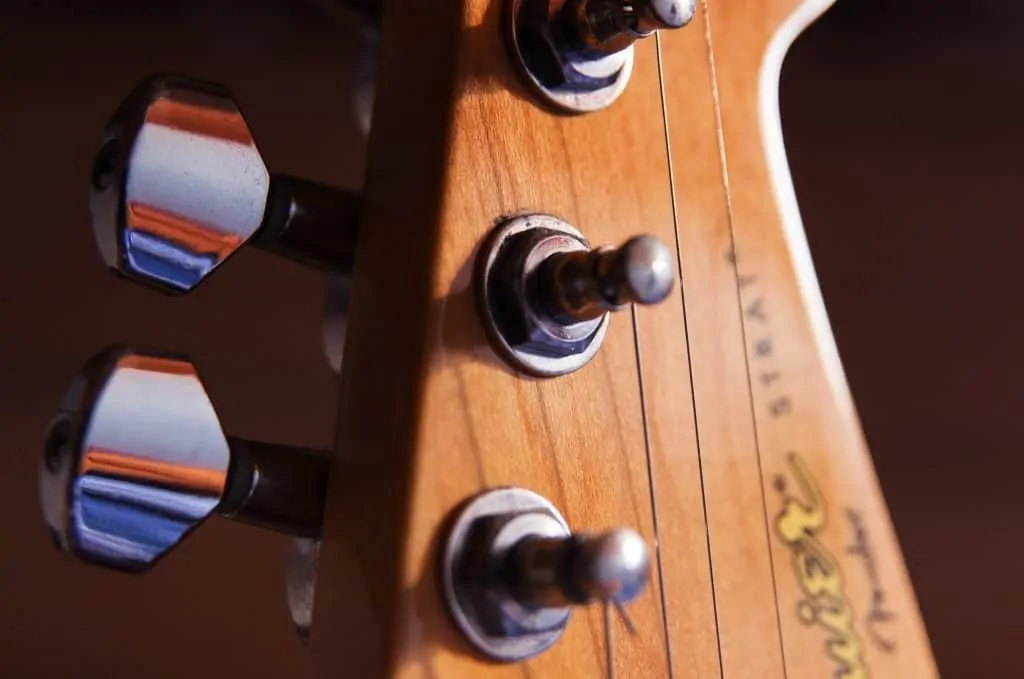
Contents
Squier Classic Vibe Telecaster ‘50s review
The Squier Classic Vibe Telecaster ‘50s is, to me, the best guitar of the Squier Classic Vibe Telecaster household. It’s also the most affordable, although it has a mid-level price tag.
Before we begin, take a look at this guitar…
Do you need me to say something more? Because it looks ooze on quality, and they are not deceiving.
It looks sweet, creamy, and classy. It looks like the guitar we keep dreaming about when we grew up thinking of having a guitar swinging around our arms while thousands of people screamed our names…
Indulge me here…you’re a kid and you’re beginning your musical journey. You go to the local music shop every once in a while and with the short resources you had, you managed to buy a guitar lesson, maybe a piano sheet, and your first acoustic guitar.
There was nothing much of interest in the store. It was a modest place run by a modest person.
Every once in awhile, though, there was a guitar peaking out the window that could just swallow the attention of the whole block. Right at the front, gathering bigger and bigger crowds, musicians and otherwise. And as soon as we realized, we became fixated…
We became obsessed with a Fender classical electric guitar.
Fast forward 15, 20 years into the now, and these kinds of guitars still moves us. Only this time we’re adults and we can afford them.
Thus, I present the Squier Classic Vibe Telecaster ‘50s as a mid-level priced professional guitar that has nothing to envy their Fender bigger brothers.
See, Fender’s Classic Vibe series is a “premium” range, and now their subsidiary brings us the affordable versions for those of us that can’t afford the “real” thing. The joke’ on them, though, as Squier’s version sounds even better.
Modern Telecasters haven’t ventured too far from the original sound of the model.
It’s premium, punchy, and amazing. It comes in Vintage Blond color (translucent wait) with a pair of superb single-coil pickups made of quality Alnico V material (more on pickup characteristics here).
Body: back to the basics
This guitar combines a pinewood body with hotter pickups to ensure this Telecaster stands on the mix and on the stage. Needless to say, it features the classical Telecaster look, so it’s a 100%-designed-by-Fender guitar.
When Leo Fender produced the first Telecaster prototypes in 1949, he built them with a pine body, so the Squier Classic Vibe Telecaster is just a remembrance of Fender’s original ideas.
The original guitar is made of solid ash since the late ‘50s it the fact that recent Fender Custom Shop Telecaster models are made of pine showcase how good this tonewood is. It’s a premium material through and through.
The only reason why Leo Fender moved from his guitars (the original Telecaster and their look-alike forefathers, the Esquire and the Nocaster) was that he wasn’t sure about using softwoods on the body.
That brings us to the “downside of pine,” it’s not as sturdy as ash, so it might scratch, bend or break if you’re not careful. And, believe me, you’re going to be careful with this beauty.
I’m putting so much emphasis on Pine because I believe this is an important reason why the Squier Classic Vibe Telecaster is just as good, if not better, as Fender’s Classic Vibe Telecaster. See, Pine is cheaper than ahs because it’s lighter and softer; but it also has great resonance and balance.
Lastly, the body is sealed with cots of polyester to protect it, and so it shows a bit of grain on the wood that makes you think of the ‘50s.
Fender designed and launched the Telecaster model before the Stratocaster in 1955.
Design: classic rock&roll with modern improvements
This guitar looks like an early ‘50s Blackguard Telecaster with a slim 9.5’’ radius maple neck and 21 medium jumbo frets. The original guitar was bigger and had a bulky maple neck.
Now, the flatter and modern 9.500 radius makes it feel more comfortable and improves the action alongside the whole fretboard. Plus, it gives you easier access to the fretboard above the 12th fret.
It’s a C-shaped neck, a modern commodity that gives the guitar more playability. And because of the classical Telecaster cutaway design, you’ll be able to reach all of the 21 frets nicely.
This vintage Tele also has a black scratchplate, which is something that can’t miss on an old-school Fender guitar. The maple neck is also lacquered and has a nice finish that helps you glide up and down the fretboard. Plus, it has the nice addition of black inset dots.
Next, you can find the standard Telecaster bridge with three adjustable brass barrel saddles.
On the head, you’ll find vintage-style tuners with a rectangular shape for a traditional feel. Just like any vintage Fender and Squier guitar, both the bridge and the tuners do an admirable job.
All of the pieces (including the pickups) are covered in nickel for that chrome look.
A drawback? You won’t want to put the Squier Classic Vibe Telecaster ‘50s down.
Pickups and sound: where the guitar comes alive
The Squier is packed with two Fender-designed Vintage-Styled Single-Coil Telecaster Pickups made of Alnico V, which is quite a mix:
- Vintage pickups have low outputs because they mimic the weakened pickups you find on classic guitars. These are made to offer cleaner sounds and a wider dynamic range. Dynamic range means the space between the highest hearable note and the hearable noise.
These kinds of pickups are made for classical and soft rock genres, reggae, funk, indie rock, alternative rock, blues, and everything in between.
- Alnico V material has a high output and delivers fat sound. It also offers plenty of versatility.
Alnico V pickups are considered “high pickup,” great for heavier genres of music and distortion channels, distortion pedals, and natural overdrives through tube amps.
See, vintage outputs generally go with Alnico III, which features the softer and most gentle sound. But now, we got hot pickups with a vintage style that can growl and still feature that slight imperfection and predictability factor we love so much about old-school music. It’s a sound that’s alive.
The result is a guitar with the legendary Telecaster tonal versatility, which can cover anything from jazz to hard rock. And it can easily stand on the mix as the main protagonist.
Here’s a showcase of the tone, which I find to be soft, clear, and yet still raw:
Controls
There’s something I absolutely love about Telecaster guitars which are how easy it’s to use them. This one is no different as it offers just two knobs (master tone and master volume). In particular, the tone volume has a very wide range.
Then, we find the classic 3-way switch:
- When the switch is on the left, just the neck pickup sounds, which has a uniquely warm and mellow sound jazz and blues players used to like. This is great for clean sections as well as soft rythm sections.
- When the slider is on the right, only the bridge pickup sounds. It delivers the coveted “Tele Twang,” a crispy sound with sharp highs, clear lows, and punchy mids. The sound is never so heavy and never too much. Instead, it’s a delight.
- On the central position, both pickups are on. It gives you a warm bottom end, mellows on the mids, and crunchy highs. It’s a distinctive sound that has a soft-clipping and works amazing with an amps’ distortion channel.
Even so, you have to “earn” this sound, which is why I said this is a guitar for experienced players and not for beginners. To achieve the best possible tons, you have to play around it and tweak your amp correctly. You just won’t get it right out of the box.
Additional info
- Tonewoods: pinewood
- Neck: C-shaped neck;
- Scale: medium-scale guitar (25’5’’);
- Fingerboard: 21 medium-jumbo frets, 9.5’’ fretboard radius;
- Pickup configuration: SS;
- Controls: Master Volume, Master Tone, 3-way switch.
- Strings: Fender USA 250L Nickel Plated Strings (.009-.042 Gauges)
More info about what to look for in an electric guitar here.
In summary…
The Squier Classic Vibe Telecaster ‘50s is a spectacular instrument that excels in every way. It has no drawbacks, no compromises, no cheapness to it.
What’s best about this guitar is how it follows the original Telecaster guitar with a couple of changes. It shows just how genius Leo Fender was as his creations have stood the test of time, and more than 70 years have passed now since then.
Is not that Fender has run out of ideas. Instead, the Telecaster is such a good guitar that it’s truly timeless. It’s a model that has created the sounds of generations. It’s a pillar of modern music, and it’s printed on the flag of rock n’ roll.
This is a guitar you’d want to buy and hang on your wall. And this is a guitar you won’t go to long without playing. It looks amazing, it plays amazing, and it sounds amazing.
And as I’ve run out of nice things to say about this guitar, I must only highlight its price. It’s so affordable it makes you wonder how come Fender and other companies like Gibson or Gretsch build guitars with such expensive electric guitars.
If you’re lucky enough to find one and have the budget, definitely get the Classic Vibe Telecaster ‘50s. That is if you want to enjoy a professional Telecaster sound with the unique crunchy & mellow sound this guitar has.
Squier Classic Vibe Series Review
The Squier Classic Vibe line-up is Squier’s most prestigious lineup. Fender’s subsidiary introduced it back in 2008 and quickly established these guitars and basses as some of the finest models the company ever did.
Additionally, these instruments have become some of the best options you could find at mid-level prices, aside fro alternatives that truly sound like a Fender instrument that sells for twice its price…at least.
The lineup provides a range of affordable instruments based on Fender’s classic designs, and they combine classic sounds, vintage looks, modern circuits, and great values.
In 2019, Squier revamped the Squier Classic Vibe lineup, which gives people more choices on pickup configurations and models. They even added a couple of Bass VI models in some regions.
I talked wonders about the ‘50s Telecaster guitar, and most of the same things could be said about every other model of the series. Let’s see…
Incredible value
This is probably the first thing that caught your eyes, which is why we put it first
It’s very common to see ‘60s guitar replicas on sale for triple zero ciphers. Because of the handcraft, innovation, and history behind vintage instruments, this kind of gear is expensive. More so when you consider how hard it’s to find them.
But now we got these easily available instruments that are price only on numbers because nothing about them is cheap or talks cheap. In fact, I bet if you played one of these instruments blindfolded, you’d say this is a triple-zero instrument.
So, if you’re looking to buy the best cheap guitar that plays, sounds, and looks like a vintage expensive instrument, the Squier Classic Vibe is your choice.
100% Fender-designed
First of all, I have to highlight every component of the 2019 Squier Classic Vibe brand is designed by Fender. Everything from the pot knobs to the pickups is made by the parent company.
This means the overseer ensures these instruments feel, play and sound more like a genuine Fender than ever before. More so, Fender packed the familiar Fender sound on thee instruments, and by that I mean the sparkle and nuances we’ve come to know and love from old-school music.
Inspired by Vintage Fender instruments
The new Squier Classic Vibe is based on genuine Fender models from the ‘50s, ‘60s, and ‘70s. Modern twists include new faces, controls, and pickups to improve the sound and playability even more.
For example, you can find Stratocaster guitars with a humbucker in the bridge position or Telecasters with two humbuckers. Despite these changes, the aesthetics of these instruments replicate the original ones on their respective time periods – from the head, to tuners, to bridge, to body and fretboard.
High playability
All of 2019 and above Squier models sport high levels of playability, as this company has improved so much on their designs over the last 5 or so years.
And even when the Classic Vibe series is modeled after early Fender instruments, the kind of playability you find on them belongs to modern instruments.
For example, the C-shaped neck profile or a 9.5’’ fingerboard radius is comfortable for any kind of player.
Additionally, the series has lower-bout cutaways that give you easy access to the neck’s upper frets, whilst Narrow Tall frets give you extra finger control.
Ideal for beginners and pro players alike
I said the Squier Classic Vibe Telecaster is very friendly for beginners for achieving the best sounds is not the easiest thing.
Still, the series has high levels of playability, affordable prices, and hot aesthetics. That’s why I consider the series a great choice for beginner players looking to get a pro guitar they can hold for many years, even in the most professional scenarios.
When you consider the quality you’re getting in terms of construction, design, and tone, then these guitars could also become an ideal choice for pro players looking to upgrade their budget guitars.
In summary, I must say the 2019 Squier Classic Vibe series took a friendly affordable reputation they’ve built over the years and hyped it to a more prestigious showroom.
Is this series as good as a Fender instrument? I believe the answer is yes. Keep in mind the price of Fender original vintage instruments is about 6x the time.
Top 6 Squier Classic Vibe instruments
I’m ending this guide with my pick of the best 6 Squier Classic Vibe guitars. I took into consideration the pickups, tone, design, body, and finish.
Now, take a look at these affordable jewels:
- Squier Classic Vibe 50s Telecaster Precision Bass
Look at this beauty. How it looks is reason enough to buy it.
This is The Original Fender Precision bass.
And it’s still the best.
See, I’m a bass player in love with Precision basses. No matter how they come, what they look like, or what series they belong to, Precision basses sound like rock music should sound. And I find that’s a signature sound pretty hard to best or imitate.
This particular model is built exactly like Fender made their first Precision bass.
More so, it boasts a gorgeous finish on its pine body, and it’s custom single-coil pickups deliver that godly old-school Precision Bass tone.
It’s punchy, crunchy, round, funky, premium, and vintage. It has such a loud and clear tone it really fills the gab bass players are supposed to fill.
- Squier Classic Vibe Telecaster Thinline 60s
Fender’s Thinline guitars are semi-hollow. The Classic Vibe Telecaster Thinline is also a semi-hollow guitar that showcases a unique look that’s elegant and sparkly, like a champagne bottle about to pop.
The F-hollow gives the guitar an authentic resonant sound that enhances sustain, and it adds aesthetic appeal that looks as good as it sounds.
The tone is pure alternative rock: mellow, gentle, and soft:
This vintage guitar is armed with a pair of warm Vintage-Style Single-Coil Telecaster Pickups with Alnico V as well.
Here’s a bundle for beginners. It includes guitar picks, a guitar tuner, a set of strings, a cloth, a guitar lesson, and a cable
- Squier Classic Vibe Telecaster Custom 70s
I’ve always been attracted to Telecaster guitars for how they look, how the sound, and the simple control layout they feature.
This particular Custom Telecaster is very special as instead of having two single-coil pickups, it features a “Wide Range” humbucker in the maple neck position.
It means this Deluxe model features greater sounds possibilities and can play metal genres comfortably whilst still getting the clarity, warmth, and nostalgic sound of Telecaster guitars.
It’s a solid guitar with a solid rock sound and a superb versatility. The price, though, is a bit higher than the others.
More so, as you can tell, it has a more complex control layout to give you additional control over the pickups: it has two individual volume controls, two individual tone knobs, and a 3-way switch.
- Squier Classic Vibe 60s Jazz Bass
I also discovered many years ago that having a Jazz Bass in my arsenal is an amazing thing. These are comfortable and lighter than Precision basses, so they might allow you to reach more complex basslines.
More so, they have more articulate tones and thus more versatility. They can reach most music genres despite its name, which is why they’re such a huge name in the music industry.
The Squier Classic Vibe Jazz Vibe ‘60s has all of the premium elements of its Fender big brother when it was first introduced in the 1960s. It looks groovy, has fast playability, and sports two custom single-coil pickups with plenty of tonality and flexible controls.
Additionally, it has a “HiMass” bridge which gives this instrument a massive sustain and a vintage-style tone with a punchy up-front sound.
In summary, this is truly a 1960s Fender Jazz Bass. Personally, though, I prefer the sound of a P bass as the J bass is generally brighter, which is not my style.
- Squier Classic Vibe 70s Stratocaster
The Stratocaster guitar is also a staple of rock and blues music, so this list wouldn’t be complete without a Strat.
The 70s-inspired model feature the classic 3 single-coil pickup configuration, but still gives you a surprising amount of versatility.
The sound is crunchy and it sounds very good on the stage. It can comfortably be your main gigging guitar.
As a great extra compared to the Tele is its vintage-style tremolo system so you can express your bendings to your heart’s content.
- Squier Classic Vibe 70s Jaguar
The Jaguar is an amazing electric guitar with a complex layout and an incredible amount of versatility.
The Classic Vibe ‘70s Jaguar turns is a retro guitar with dual Fender-designed single-coil pickups with Alnico V.
It has an offset short scale 24’’ body which is slim, comfortable, and friendly for beginners and children.
The highlight of this guitar is its unique sound achieved by its unique pickups. The tone is crystal clear and distinctive at any amount of volume or distortion.
This guitar stays faithful to the original Jaguar and sounds as good, if not better than any overpriced Fender Jaguar guitar.
Final Considerations
The original Fender instruments
Time has passed since Fender stormed into the music industry with 4 models that have been at the top of the market for over 70 years.
And vintage instruments are coveted, priced, and hard to find for a reason. Fender’s original ‘50s, ‘60s, and ‘70s instruments sell for about 6 times the price of a Squier Classic Vibe guitar or bass guitar.
Even as Fender has continued improving or, more precisely, changing these instruments, people still love to go back to the original Leo Fender ideas. Why? Because he was a genius who created timeless technology and timeless designs.
And, in fact, Fender hasn’t changed much since them but the quality of electronics and pickups. This is why Squier’s Classic Vibe series is soo god: it has practically the exact same designs of the original Fender models plus new pickups and electronics and a greatly improved bridge. Also, it features some newer contours on its body and maple neck to give players more ease.
The Squier Classic Vibe series is just as good as a Fender.
So, in conclusion, Squier’s Classic Vibe series is a premium lineup that sounds, looks, and feels like a vintage Fender instrument with a couple of modern twists. And vintage Fender instruments made most of the music we rockers love and lust.
And they managed to make it so affordable as, like all things, when time passes by technology becomes cheaper and more available to us mortals.
We don’t have to pay $$$$ to get professional sound anymore. Such a great time to be a musician.


